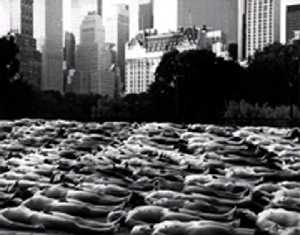Issue 82, Summer 2001
 |
by Svetlana Mintcheva
From the Senate Office Buildings to exhibition spaces on both coasts, nudes are becoming taboo. In Lake Alfred, Florida you can find a replica of Michelangelo’s David wearing a loincloth; in Santa Cruz, California, watercolors of nudes were unpalatable to a community arts center director; in Spokane, Washington, a mural of stylized human figures was painted over. The same reasons are given: children might see, adults might feel “sexually harassed,” and, in short, representations of naked human bodies are obscene and pornographic.
Obscene and pornographic?
The Greek masters attached great importance to the naked body because it expressed their sense of human wholeness, of spirit and body as one. In the Middle Ages Christian dogma, together with the denunciations of the pleasures of the senses and the condemnation of woman, transformed the body from an image of divine perfection to an object of shame. The Greek proud heroic body became the humiliated body of Adam or Eve, huddled with the consciousness of sin. In the Renaissance, thinkers and artists rediscovered the beauty and dignity of the human body, believed to be the visible externalization of spirit. In the 20th century, the nude becomes increasingly contorted by pain, weighed down by old age, marked by time and suffering; however, it also brings an aesthetic perspective to the complexity of embodied human life and offers a glimpse of redemption from the anguish of history.
Yet, at the dawn of the new millennium, the assumption is gaining ground that the simple sight of a nude would be harmful to children and offensive to adults. The body is covered with shame again.
There is no evidence that the sight of a nude would in any way harm children. The misnamed “harmful to children” laws, where they exist, have been designed chiefly to make commercial pornography unavailable to minors. These laws apply only to material that is found to be legally obscene, i.e. appeals, as a whole, primarily to the prurient interest, is offensive by community standards, and has no redeeming social, political or artistic value. Even though what ranks as obscene for children is more inclusive than what is obscene for adults, the simple representation of a nude is certainly not obscene.
As for adults—it is impossible to take out of sight everything that disturbs somebody’s sensibilities, so we either choose to conform to the beliefs of one group at the expense of all others or admit that our interpretations are not necessarily valid for all. Pornography, for instance, remains a term of largely subjective evaluation. The interpretation of a work of art as “pornographic” is often more revealing of the beholder than of the intentions of the artist: there is a mind-boggling range of things people find sexually stimulating and the abstract representation of a human form could well be one of them (it is, however, worth remembering that shoes are another possible stimulus and their representation remains, at present, uncensored).
Take out the nudes and you condemn Michelangelo, Titian, Rembrandt, Manet, and Picasso; take out the nudes and you destroy a living language of visual expression. But more than that, wrapping the human form in shame alienates us from our own bodies. Paradoxically, we live in a culture obsessed with engineering the perfect figure: through relentlessly working out at the gym if possible, through tummy-tucks, acid peels, face-lifts and extreme diets if necessary. Shame and obsession both deny the reality of the imperfect, yet still beautiful in its imperfections, human body. We know some vital connection is broken when 14 year olds look in the mirror and see their skeletal bodies as too fat. Perhaps art offers us a chance to break through the process of alienation, to see once more the grace and truth of the real body—weighed by age, swollen with pregnancy, bent, sagging, flawed—a body through which we see the spirit in all its pain and joy.

